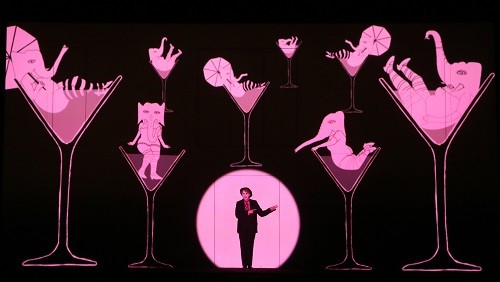 United States Mozart, The Magic Flute: LA Opera, James Conlon (conductor), Dorothy Chandler Pavilion, Los Angeles, 13.2.2016 (JRo)
United States Mozart, The Magic Flute: LA Opera, James Conlon (conductor), Dorothy Chandler Pavilion, Los Angeles, 13.2.2016 (JRo)

Cast:
Tamino: Ben Bliss
Pamina: Marita Sølberg
Papageno: Jonathan Michie
Queen of the Night: So Young Park
Sarastro: Wilhelm Schwinghammer
Monostatos: Brenton Ryan
First Lady: Stacey Tappan
Second Lady: Summer Hassan
Third Lady: Peabody Southwell
The Speaker: Nicholas Brownlee
Papagena: Vanessa Becerra
First Armored Man: Frederick Ballentine
Second Armored Man: Nicholas Brownlee
Production:
Concept: 1927 (Suzanne Andrade, Paul Barritt)
Scenery and Costume Designer: Esther Bialas
Directors: Suzanne Andrade & Barrie Kosky
Animation: Paul Barritt
Chorus Director: Grant Gershon
Comical, effervescent, and packed with visual stimulation, LA Opera’s The Magic Flute returned to the Dorothy Chandler Pavilion on Saturday after its acclaimed run here in 2013. From the minds of director Barrie Kosky and the English theater team of Suzanne Andrade and Paul Barritt, and a production of the Komische Oper Berlin, this is a Magic Flute to remember. The video projections, which dominate and often hijack the opera, immerse the audience in an animated universe, and are nothing if not memorable.
Set in the 1920s in an imagined world that reflects the excesses of Weimar Germany and Hollywood’s silent film era, invention followed invention, spinning out a dizzying array of cartoon images on a screen that covers the full height and width of the stage. Pink elephants in stockings and garters, vultures with skeleton heads, tarot cards, feral dogs, floating lips, clockwork mechanisms, and a black cat paraded through our visual field.
At its best, singers interacted with the projections in beguiling ways. Prince Tamino, swallowed whole by the Serpent, cowered in the animated creature’s belly. Monostatos, pursuing the Princess Pamina, “held” a video projection of the reins of a vicious animated dog bent on devouring her. Papageno and Papagena, united at last and imagining their love-nest, stood at the entrance to a projection of a cutaway house, surrounded by an ever-increasing number of little Papagenos and Papagenas who crowded its rooms.
But the inventiveness of the production is also its weakness: very few moments of visual peace leave one struggling to focus on the singers. If you’re seated close to the stage (as I was at the 2013 performance), the singers can be observed more easily and are able to hold their own against the onslaught of images. But if you’re further back, they become footnotes to the projections ̶ a cast of three-dimensional characters within an animated film. Make no mistake – it’s a whole lot of fun, but if you go to the opera to contemplate the singing, you might leave unsatisfied.
However, with a uniformly solid and attractive cast of young singers, there was enough talent on stage to compete with the distraction. Ben Bliss as Tamino was a tender hero with a clear sweet sound, perfect for Mozart. Marita Sølberg sang Pamina with silky warmth that embodied both joy and heartbreak. And Jonathan Michie, with his pliant baritone and comedic timing, carried off the Buster Keaton-style antics of Papageno with gusto.
So Young Park was a wonder. She managed to flawlessly sing the Queen of the Night while perched on a high shelf (the video screen had doors that opened and shelves of varying heights on which the singers stood), arms pinned to her sides, and wrapped up in white fabric like a baby in swaddling. As I noted in my 2013 review, the Queen, presented here as a terrifying, evil spider woman, failed to honor Mozart and Schikaneder’s conception, leaving no ambiguity about her character. This ambiguity is central to the plot. Much of the narrative tension of The Magic Flute grows out of our concern for Pamina. Who are we to believe has her interests at heart: the Queen or Sarastro? It is the slow reveal of the Queen’s true nature that finally answers the question.
Restricted to a high perch, Wilhelm Schwinghammer as Sarastro had no chance to move or act. Through voice alone, he gave appropriate gravitas to the high priest of the brotherhood of the sun. As the Three Ladies, Stacey Tappan, Summer Hassan, and Peabody Southwell were delightfully mischievous.
Mozart’s sublime music was in excellent hands with James Conlon leading the LA Opera Orchestra and Chorus. Light and dark, tender and tragic, comic and serious – all the shadings of the score were present in one harmonious whole. The spoken lines of the opera were replaced with the 1920s silent film convention of written dialogue and exposition on the screen. Mozart’s fantasias for piano, played on an eighteenth-century fortepiano, supplied the musical underscoring. It was a clever device, making for a more concise production, but it did have the misfortune of leaving out some key narrative points.
There is a freshness and modernity to the production that adds to the wonder inherent in Mozart’s gem. This Magic Flute has undeniable popular appeal and might just tempt a new audience to enjoy a night of animated fun in downtown LA.
Jane Rosenberg